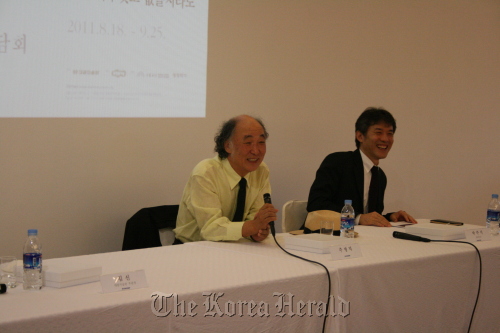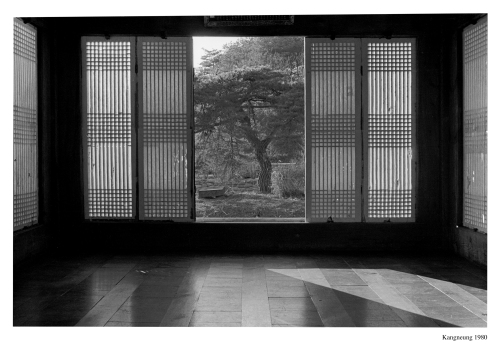Finale of Daelim Contemporary Art Museum’s four-year-long project on Joo Myung-duck showcases over 830 photos
A photo shows an empty room in a Gyeongju “hanok,” or Korean traditional house, where everything, even time, seems to be still.
In another photo, a wooden gate is left open, as if someone had hurriedly run out and had never returned.
Silent mountains and rivers in other shots look peaceful and inviolable.
Unlike the showy city portraits most are familiar with today, the serene black and white photos taken in different provinces of South Korea from the 1960s to the present remind viewers of the grace of the country’s landscapes, and how many stories they may hold, deeply tucked away.
A photo shows an empty room in a Gyeongju “hanok,” or Korean traditional house, where everything, even time, seems to be still.
In another photo, a wooden gate is left open, as if someone had hurriedly run out and had never returned.
Silent mountains and rivers in other shots look peaceful and inviolable.
Unlike the showy city portraits most are familiar with today, the serene black and white photos taken in different provinces of South Korea from the 1960s to the present remind viewers of the grace of the country’s landscapes, and how many stories they may hold, deeply tucked away.


The photos are on display at photographer Joo Myung-duck’s ongoing solo exhibition at Daelim Contemporary Art Museum in Tongui-dong, central Seoul. Titled “My Motherland,” it is the third and final exhibition of the photo-exclusive-museum’s four-year project to shed light on the photographer.
Joo is one of Korea’s first documentary photographers to focus on critical social issues, landscapes and disappearing cultural heritages. He introduced a new genre, “Korean Realism” through his first solo show “Mr. Holt’s Orphanage” in 1966, which displayed photos of war orphans. The first documentary photos created a great sensation as most photos taken at the time were elegant indoor shots. Joo’s iconic black and white photographs are nicknamed the “Joo Myung-duck Black.”
Showing around 130 photographs of Korea’s traditional houses, relics and landscapes at the current exhibition, the photographer said that he wanted to show how beautiful the country used to be to his son’s generation, before they are all gone.
“I wanted to capture my motherland with my camera,” said Joo at a press conference on Wednesday.
“I did not only shoot things that are widely considered culturally valuable. I cannot put into words what the standards exactly were, but I chose my subjects based on what my eyes and heart took as beautiful.”
The photographer was born in 1940 in Hwanghae-do, which now belongs to North Korea, but moved to Seoul after the nation met its independence, when he was only 8. With no fixed “motherland,” he wandered around villages throughout the country and captured what touched him the most.
At this exhibition, visitors can also see 700 representative photographs by the photographer, spanning a 50-year career, in the form of a video archive. It includes his earlier photos; the “Cityscape” series which were the main features of his 2008 show at Daelim; the “Landscape,” series which were included in his 2009 show at Daelim; to the most recent “Roses” series.
“It is unprecedented for a museum in Korea to conduct a four-year project of holding three exhibitions, publishing a book and establishing an exclusive archive on a single artist,” said Park Joo-seok, professor at Myongji University and curator of the exhibition.
“At the exhibition, please focus on what kind of angle Joo used. In Korea, we have a culture of sitting on the floor. So we have been constructing buildings in a way to show the best view when people are sitting down. If you are standing up, like Westerners, you miss out many beauties. Joo knew how to use the angles,” Park added.
The exhibition runs through Sept. 25 at Daelim Contemporary Art Museum in Tongui-dong, central Seoul. Tickets range from 2,000 won to 5,000 won. For more information, call (02) 720-0667 or visit www.daelimmuseum.org.
By Park Min-young (claire@heraldcorp.com)







![[KH Explains] How should Korea adjust its trade defenses against Chinese EVs?](http://res.heraldm.com/phpwas/restmb_idxmake.php?idx=644&simg=/content/image/2024/04/15/20240415050562_0.jpg&u=20240415144419)











![[Today’s K-pop] Stray Kids to return soon: report](http://res.heraldm.com/phpwas/restmb_idxmake.php?idx=642&simg=/content/image/2024/04/16/20240416050713_0.jpg&u=)